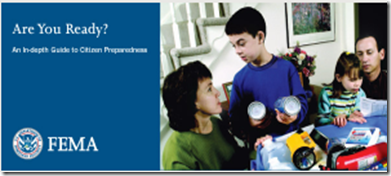# 6284
After watching Doomsday Preppers on the National Geographic Channel some may come away thinking that all preppers are crazed fanatics gearing up for an impending apocalypse. But for the vast majority of those who embrace the preparedness lifestyle - it is the far more common localized disaster that spurs them on.
Of course, if you want decent cable TV ratings, you don’t profile people who maintain a 14 day supply of necessities in their pantry, volunteer for CERT, have a family emergency plan, or take pride in keeping a well stocked first aid kit.
No . . . you focus on families with elaborate underground bunkers, a 20 year supply of freeze-dried foods, and a firm belief that the end is nigh.
It is TV, after all.
While we collectively wait for doomsday (and I’m perfectly content to wait a long, long time for mine) we are nonetheless faced with an ongoing parade of lesser - but no less burdensome to those affected – localized disasters.
Earthquakes, hurricanes, floods, tornadoes . . . .
They happen with surprising regularity - and unlike an abrupt 30 degree shift of the earth’s crust or the eruption of the Yellowstone Super Volcano - are something being prepared for is actually likely to help.
Later today parts of the Midwest will be under the gun, with a high risk of severe weather. NOAA’s Storm Prediction Center in Norman, OK has released the following forecast.

For a sobering look at the disaster potential of a `high risk’ day like today, I can heartily recommend a recent blog post by Minnesota Meteorologist Paul Douglas.
Tornado Warning: "One of These Days a Single Tornado Will Claim Over 1,000 American Lives"
Posted: 04/ 4/2012 3:44 pm
Today the residents of Oklahoma City, Tulsa, Omaha, Nebraska, and surrounding areas find themselves at a high risk of severe weather, including possible tornadoes. Hundreds of thousands more will find themselves at moderate risk.
While we can hope that these predicted storms do not materialize, hope is not a plan.
The smart move for those in harm’s way this morning is to review their emergency plan with all family members, double check their supplies, and ensure that they can keep tabs on approaching threats by way of a battery powered NOAA weather radio.
You don’t have to suffer a direct hit from an F5 tornado to be glad you were prepared.
A severe storm can knock out electrical power and phone service for days, sometimes weeks. Public services (including 911) can be severely disrupted, and something as routine as obtaining food and potable water for your family may be difficult for several days.
There are many legitimate disaster threats out there, which is why FEMA, READY.GOV, and many other agencies actively promote personal, family, and business preparedness.
To that end the Federal government has produced copious toolkits, brochures, pamphlets, and even mobile apps designed to help citizens prepare . . . for just about anything.
One such toolkit is FEMA’s Are You Ready? An In-depth Guide to Citizen Preparedness (IS-22) – which, at 204 pages – ranks as one of the most comprehensive guides to public preparedness available.
FEMA describes this guide as:
An In-depth Guide to Citizen Preparedness
Are You Ready? An In-depth Guide to Citizen Preparedness (IS-22) is FEMA’s most comprehensive source on individual, family and community preparedness. The guide has been revised, updated and enhanced in August 2004 to provide the public with the most current and up-to-date disaster preparedness information available.
Are You Ready? provides a step-by-step approach to disaster preparedness by walking the reader through how to get informed about local emergency plans, how to identify hazards that affect their local area and how to develop and maintain an emergency communications plan and disaster supplies kit. Other topics covered include evacuation, emergency public shelters, animals in disaster and information specific to people with access and functional needs.
Are You Ready? also provides in-depth information on specific hazards including what to do before, during and after each hazard type. The following hazards are covered: Floods, Tornadoes, Hurricanes, Thunderstorms and Lightning, Winter Storms and Extreme Cold, Extreme Heat, Earthquakes, Volcanoes, Landslide and Debris Flows (Mudslide), Tsunamis, Fires, Wildfires, Hazardous Materials Incidents, Household Chemical Emergencies, Nuclear Power Plant and Terrorism (including Explosion, Biological, Chemical, Nuclear and Radiological hazards).
<SNIP>
For more publications on disaster preparedness, visit the Community and Family Preparedness webpage.
Are You Ready? An In-depth Guide to Citizen Preparedness Full Document (PDF - 21Mb)
Disasters happen.
And while they don’t often occur on a national or international scale (an assumption with which residents of Haiti, Pakistan, and Japan might take exception), they can be devastating to large segments of our population.
While some of the more elaborate preparations shown on cable TV admittedly look more than a little screwy (even to this committed prepper), the greater delusion is in doing nothing and simply hoping for the best.
Some disaster plans may be screwy, but having no plan is just plain nuts.

